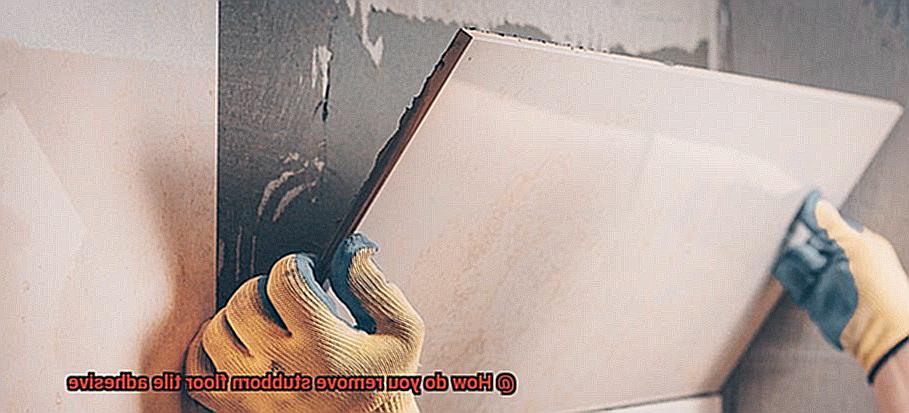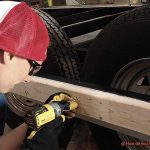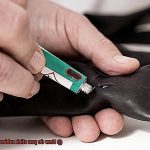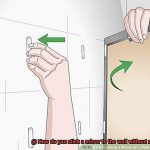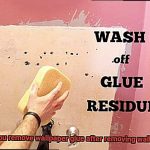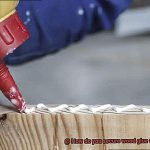Are you ready to level up your living space with a new floor? If you’re planning to replace old tiles, dealing with the leftover adhesive can be a real pain. But don’t throw in the towel just yet – we’ve got your back. In this blog post, we’ll show you how to remove stubborn floor tile adhesive like a pro.
We all know that feeling of frustration when we’re trying to get rid of sticky residue that just won’t budge. It’s even worse when it comes to removing tough, resilient adhesive from flooring. But fear not, there are tried-and-true methods for tackling this problem that are both effective and safe.
In this article, we’ll explore different techniques for removing stubborn floor tile adhesive from concrete or wood surfaces. We’ll also cover safety precautions you should take before starting the process, so you can confidently tackle this challenging task without any mishaps.
By following our easy-to-follow guide, you’ll discover that removing stubborn floor tile adhesive can actually be a satisfying DIY project. So why wait? Get ready to roll up your sleeves and enjoy the gratifying feeling of seeing your new floors come to life.
Mechanical Methods for Removing Floor Tile Adhesive
Contents
- 1 Mechanical Methods for Removing Floor Tile Adhesive
- 2 Chemical Methods for Removing Floor Tile Adhesive
- 3 Natural Methods for Removing Floor Tile Adhesive
- 4 Safety Precautions to Take When Removing Floor Tile Adhesive
- 5 Pros and Cons of Different Methods for Removing Floor Tile Adhesive
- 6 Common Mistakes to Avoid When Removing Floor Tile Adhesive
- 7 Tools and Materials Needed for Removing Floor Tile Adhesive
- 8 Tips and Tricks for Easier Removal of Floor Tile Adhesive
- 9 Conclusion
Removing floor tile adhesive can be a daunting task, but with the right tools and techniques, it can be done efficiently and effectively. Mechanical methods are one of the most successful ways to get rid of stubborn adhesive residue that may be left behind after using chemical solutions.
One of the most popular mechanical methods is using a floor scraper or hand scraper. A floor scraper is a versatile tool with a long handle and a wide blade, perfect for scraping off the adhesive from the surface. Ensuring that the blade is sharp enough and applying enough pressure guarantees successful removal of the adhesive. On the other hand, a hand scraper is ideal for tight spaces or smaller areas that require more precise work.
If you’re dealing with thicker layers of adhesive, using a chisel or a hammer and chisel may be necessary. This approach requires more physical effort but can be effective for removing tough adhesive residues. It’s crucial to wear protective gear such as goggles and gloves when using this method to avoid injury.
Grinding machines are another option for removing floor tile adhesive. These machines use abrasive discs or pads to grind away at the adhesive until it’s removed from the surface. This technique is suitable for larger areas but may require professional equipment and expertise.
Sanding is also an option for removing floor tile adhesive. Sanding involves using sandpaper or a sander to smooth out and remove the adhesive from the surface. This method may not be as effective for thicker layers of adhesive but works well for smaller areas or finishing touches.

When using any mechanical method, it’s crucial to follow proper safety protocols and use appropriate protective gear such as goggles, gloves, and respirators. Additionally, testing each method on a small area first before proceeding with larger areas ensures that the method is effective without damaging the surface underneath.
Chemical Methods for Removing Floor Tile Adhesive
Say goodbye to stubborn floor tile adhesive with the help of chemical methods. These powerful solvents are a go-to choice for both professionals and DIYers due to their effectiveness in dissolving even the most stubborn adhesives. Let’s dive into the various chemical methods available for removing floor tile adhesive.
One of the most popular solvents for removing floor tile adhesive is acetone. Known for its potent solvent properties, acetone can dissolve almost all types of adhesives, including those used for floor tiles. It’s easy to use – simply apply acetone directly to the adhesive, wait a few minutes, and then scrape away using a scraper or putty knife.
Another effective solvent is mineral spirits, which are petroleum-based and can break down adhesives, making them easier to remove. Apply the mineral spirits to the adhesive and let it sit for a few minutes before scraping it off with a scraper or putty knife.
If you prefer natural solvents, citrus-based products can also be effective for removing floor tile adhesive. These eco-friendly solvents work by breaking down the adhesive, making it easier to scrape off. Alternatively, commercial adhesive removers are also available for purchase.
It’s important to note that when using chemical solvents, it’s essential to follow the manufacturer’s instructions carefully. Always wear protective gloves and goggles, work in a well-ventilated area, and avoid using these solvents near open flames or heat sources.
Natural Methods for Removing Floor Tile Adhesive
Luckily, there are natural methods available that can be just as effective and environmentally friendly. Using common household items such as vinegar, baking soda, and vegetable oil, these methods break down the adhesive without compromising your health or the environment.
One of the most popular options is using vinegar. To do this, mix equal parts vinegar and water in a spray bottle and spray directly onto the adhesive. Let it sit for a few minutes before using a scraper or putty knife to remove the softened adhesive. Repeat this process until all adhesive is removed.
Another natural method is using baking soda and water. Make a paste of baking soda and water and apply it directly onto the adhesive. Leave it for 10-15 minutes before scrubbing with a sponge or brush. Rinse with warm water and repeat if necessary.
If you’re dealing with stubborn adhesive, vegetable oil may be the way to go. Apply a small amount of vegetable oil directly onto the adhesive and let it sit for several hours or overnight. The oil will soften the adhesive, making it easier to scrape off with a putty knife or scraper.
In summary, natural methods for removing floor tile adhesive are not only effective but also safe alternatives to chemical-based products. However, before applying any solution to the entire floor, make sure to test a small, inconspicuous area first.
Safety Precautions to Take When Removing Floor Tile Adhesive
Removing stubborn floor tile adhesive can be a tricky task. But before you dive in headfirst, it’s important to take safety precautions to ensure that you and those around you are protected from any harm.
First and foremost, protective gear is non-negotiable. You’ll need gloves, safety glasses, and a respirator mask to protect your hands, eyes, and lungs from any chemicals or sharp tools that you may be using. Taking this step will significantly reduce the risk of any injuries or accidents occurring during the removal process.
Ventilation is also crucial when removing floor tile adhesive. The chemicals used in the process can emit harmful fumes that could lead to respiratory issues if inhaled. To prevent this, ensure that the area where the adhesive is being removed is well-ventilated by opening windows and doors. It’s also a good idea to set up a fan to blow air out of the room, which will help remove any toxic fumes from the area.
In addition to protective gear and ventilation, it’s important to keep pets and children away from the area where the adhesive is being removed. The chemicals and tools used during the removal process can be hazardous if ingested or handled improperly. To avoid any mishaps, it’s best to keep curious kids and pets at a safe distance.
Lastly, following instructions and guidelines for any chemicals or tools used during the removal process is essential. This includes wearing protective gear, using tools properly, and disposing of any chemicals safely. Ignoring these guidelines could result in accidents or even long-term health problems.
Pros and Cons of Different Methods for Removing Floor Tile Adhesive
Removing floor tile adhesive is a challenging task that requires patience, effort, and the right tools. Fortunately, there are several methods available for removing stubborn adhesive from your floors. In this article, we’ll explore the pros and cons of three popular methods: chemical adhesive remover, heat gun or hairdryer, and mechanical scraper or chisel.
Chemical adhesive removers are a common go-to for many people. One of their biggest advantages is that they are easy to use. Simply apply the remover to the adhesive, wait a few minutes, and then scrape it off. However, these removers contain strong chemicals that can be harmful if not used properly. Fumes from these chemicals can irritate the eyes, nose, and throat, so it’s essential to wear protective gear such as gloves and a mask. Additionally, some types of adhesive may not respond well to chemical removers.
Another method for removing floor tile adhesive is using a heat gun or hairdryer. Applying heat to the adhesive softens it, making it easier to scrape off. This method doesn’t involve any harsh chemicals, making it safer for both you and the environment. However, it’s important to note that applying too much heat can damage certain surfaces like wood or plastic. Also, it may take longer to remove the adhesive using this method than it would with a chemical remover.
The third method for removing floor tile adhesive is using a mechanical scraper or chisel. This method involves manually scraping off the adhesive using a tool like a scraper or chisel. The biggest advantage of this approach is that it doesn’t involve any chemicals or heat, making it safe for both you and the environment. However, this method can be physically demanding and time-consuming.
Common Mistakes to Avoid When Removing Floor Tile Adhesive
Removing it yourself can save you money and give you a sense of satisfaction, but it’s important to avoid common mistakes that can lead to frustration and even damage. Here are some tips to ensure a successful and safe removal process:
Don’t use harsh chemicals without proper ventilation or protective gear. Not only can these chemicals be harmful to your health, but they can also damage the surface beneath the adhesive. Opt for safer alternatives such as heat or mechanical scraping.
Avoid using excessive force or pressure when removing the adhesive. This can cause cracks or damage to the subfloor, leading to additional headaches down the line. Be patient and take a careful approach, using appropriate tools and techniques for the job.
Properly prepare the area before starting the removal process. Cover nearby furniture or appliances, remove any loose debris or dirt from the area, and protect surrounding surfaces with a drop cloth or plastic sheeting.
Identify the type of adhesive used before beginning removal. Different adhesives require different approaches, so doing some research or consulting with a professional beforehand can save time and stress in the long run.
Tools and Materials Needed for Removing Floor Tile Adhesive
Removing floor tile adhesive can be a daunting task, but with the right tools and materials, it can also be a satisfying DIY project. As an expert in this area, I’ve compiled a comprehensive list of everything you’ll need to get started.
First things first – safety is essential. Protect yourself by wearing safety goggles, gloves, and a dust mask while working with adhesive remover. Once you’re properly geared up, it’s time to gather your tools.
A floor scraper with a sharp blade is a must-have when removing adhesive from the floor. Make sure to choose a scraper that’s sturdy enough to handle the job and ensure the blade is sharp. A heat gun is also incredibly helpful for older adhesives that have hardened over time. By warming up the adhesive, it will be much easier to scrape off.
Chemical adhesive removers are available in many varieties, including citrus-based and solvent-based options. It’s important to choose a remover that’s safe for your specific flooring material and follow the manufacturer’s instructions carefully. Additionally, you’ll need a bucket filled with warm water and sponges to clean up any leftover residue after scraping off the adhesive.
In addition to these tools and materials, sandpaper or an abrasive pad can be used to smooth out any rough spots on the floor after removing the adhesive. Proper preparation is also key before diving in. Clear out any furniture or obstacles from the work area and cover nearby surfaces with plastic sheets or drop cloths. Proper ventilation in the room is also crucial.
But wait, there’s more. Here are some additional tips:
- Use a putty knife or razor blade to gently remove any large pieces of adhesive before using the scraper.
- Keep a bucket of water nearby to rinse off the scraper as you work.
- Work in small sections, applying adhesive remover only where needed.
- Take breaks as needed to avoid overexerting yourself.
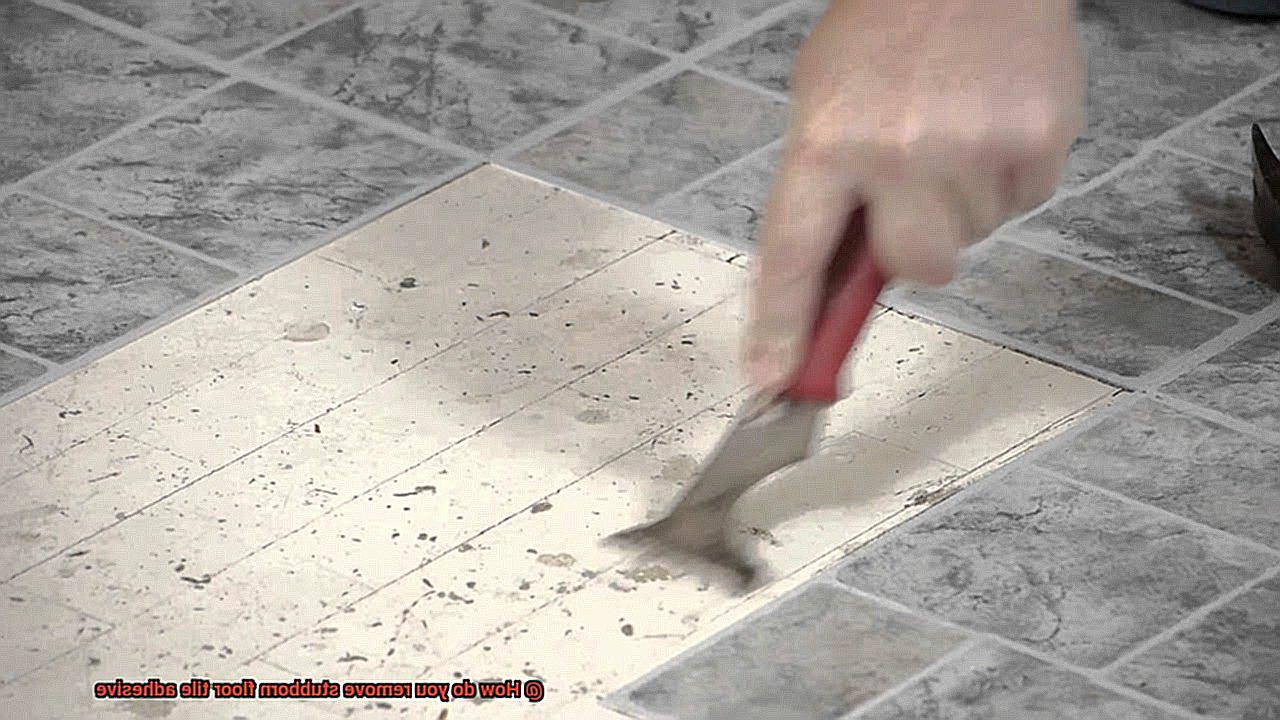
Tips and Tricks for Easier Removal of Floor Tile Adhesive
We have compiled some tips and tricks to help make this daunting task easier and more efficient.
Use a Scraper
A scraper is a handy tool that can help chip away at the adhesive and remove it piece by piece. Be sure to use a sturdy scraper with a sharp blade to make the process smoother.
Apply Heat
Applying heat is one of the most effective ways to soften the adhesive for easier removal. You can use a heat gun or hairdryer to apply heat to the adhesive, but be careful not to overheat the area and damage the surface underneath.
Use a Solvent

There are many solvents available that can dissolve floor tile adhesive. Choose a solvent that is safe for your flooring material and follow the manufacturer’s instructions carefully to avoid damaging the surface underneath.
Try Vinegar
Vinegar is a natural solvent that can help break down floor tile adhesive. Mix equal parts vinegar and water in a spray bottle and apply it to the adhesive. Let it sit for a few minutes before scraping away the adhesive.
Sand it Down
If all else fails, you may need to sand down the adhesive using a sanding machine or sandpaper. This can be time-consuming, but it will ensure that all of the adhesive is removed.
It’s important to wear protective gear like gloves and goggles while removing adhesive to avoid injuries. Proper ventilation should also be maintained as some adhesive removers emit harmful fumes.
WnJbv1Z4tuM” >
Conclusion
In conclusion, conquering stubborn floor tile adhesive requires the right tools, techniques, and safety precautions. Mechanical methods such as scraping, grinding, or sanding are popular options for tackling tough residues. Chemical methods like acetone and mineral spirits dissolve even the most stubborn adhesives. Natural remedies like vinegar or baking soda paste provide safe alternatives to chemical-based products.
However, before starting the removal process, it’s crucial to take safety precautions by wearing protective gear and ensuring proper ventilation in the work area. Avoiding common mistakes like using harsh chemicals without proper ventilation or applying too much force while removing adhesive is also essential.
To remove floor tile adhesive efficiently, you’ll need a sharp blade scraper, heat gun or hairdryer for older adhesives that have hardened over time, and chemical adhesive removers safe for specific flooring materials with warm water and sponges for cleaning up any leftover residue after scraping off the adhesive.
Finally, tips and tricks such as chipping away at the adhesive piece by piece with a scraper, applying heat to soften the adhesive for easier removals or trying vinegar as a natural solvent can make this daunting task more manageable.

